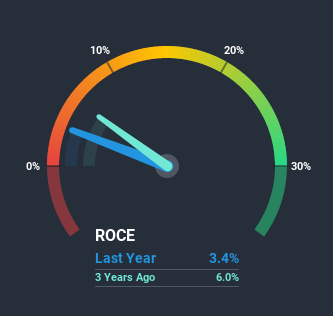- South Korea
- /
- Packaging
- /
- KOSE:A008870
Investors Could Be Concerned With Kumbi's (KRX:008870) Returns On Capital
If we want to find a stock that could multiply over the long term, what are the underlying trends we should look for? Firstly, we'll want to see a proven return on capital employed (ROCE) that is increasing, and secondly, an expanding base of capital employed. This shows us that it's a compounding machine, able to continually reinvest its earnings back into the business and generate higher returns. Although, when we looked at Kumbi (KRX:008870), it didn't seem to tick all of these boxes.
What is Return On Capital Employed (ROCE)?
For those that aren't sure what ROCE is, it measures the amount of pre-tax profits a company can generate from the capital employed in its business. Analysts use this formula to calculate it for Kumbi:
Return on Capital Employed = Earnings Before Interest and Tax (EBIT) ÷ (Total Assets - Current Liabilities)
0.034 = ₩8.8b ÷ (₩333b - ₩77b) (Based on the trailing twelve months to December 2020).
Therefore, Kumbi has an ROCE of 3.4%. In absolute terms, that's a low return and it also under-performs the Packaging industry average of 5.1%.
View our latest analysis for Kumbi

While the past is not representative of the future, it can be helpful to know how a company has performed historically, which is why we have this chart above. If you're interested in investigating Kumbi's past further, check out this free graph of past earnings, revenue and cash flow.
What Can We Tell From Kumbi's ROCE Trend?
On the surface, the trend of ROCE at Kumbi doesn't inspire confidence. Around five years ago the returns on capital were 11%, but since then they've fallen to 3.4%. On the other hand, the company has been employing more capital without a corresponding improvement in sales in the last year, which could suggest these investments are longer term plays. It may take some time before the company starts to see any change in earnings from these investments.
In Conclusion...
To conclude, we've found that Kumbi is reinvesting in the business, but returns have been falling. Unsurprisingly, the stock has only gained 6.9% over the last five years, which potentially indicates that investors are accounting for this going forward. So if you're looking for a multi-bagger, the underlying trends indicate you may have better chances elsewhere.
Kumbi does come with some risks though, we found 4 warning signs in our investment analysis, and 2 of those are a bit concerning...
While Kumbi isn't earning the highest return, check out this free list of companies that are earning high returns on equity with solid balance sheets.
When trading Kumbi or any other investment, use the platform considered by many to be the Professional's Gateway to the Worlds Market, Interactive Brokers. You get the lowest-cost* trading on stocks, options, futures, forex, bonds and funds worldwide from a single integrated account. Promoted
Valuation is complex, but we're here to simplify it.
Discover if Kumbi might be undervalued or overvalued with our detailed analysis, featuring fair value estimates, potential risks, dividends, insider trades, and its financial condition.
Access Free AnalysisThis article by Simply Wall St is general in nature. It does not constitute a recommendation to buy or sell any stock, and does not take account of your objectives, or your financial situation. We aim to bring you long-term focused analysis driven by fundamental data. Note that our analysis may not factor in the latest price-sensitive company announcements or qualitative material. Simply Wall St has no position in any stocks mentioned.
*Interactive Brokers Rated Lowest Cost Broker by StockBrokers.com Annual Online Review 2020
Have feedback on this article? Concerned about the content? Get in touch with us directly. Alternatively, email editorial-team (at) simplywallst.com.
About KOSE:A008870
Kumbi
Manufactures and sells glass bottles, bottle caps, cosmetics, and plastic products in South Korea.
Acceptable track record second-rate dividend payer.
Market Insights
Community Narratives



